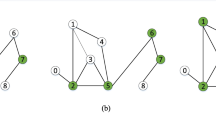Abstract
The minimum independent dominating set (MIDS) problem is a popular NP-hard combinatorial optimization problem which has been widely used in various fields. In this paper, a tabu search-based memetic algorithm is designed for MIDS based on two novel ideas, i.e., the forgetting-based vertex weighting strategy and the repairing-based crossover strategy. The former strategy utilizes the current information of local search and simultaneously plays a key role in exploiting the possible spaces. On the other hand, the latter strategy not only inherits the results of parent solutions, but also makes up the infeasible solution. Furthermore, the tabu mechanism is used to solve the serious cycle problem arising in the search process. The experimental results show that our memetic algorithm performs better than a previous state-of-the-art heuristic algorithm for MIDS on DIMACS benchmark.


Similar content being viewed by others
Explore related subjects
Discover the latest articles and news from researchers in related subjects, suggested using machine learning.References
Michael RG, David SJ (1979) Computers and intractability: a guide to theory of NP-completeness. WH Freeman, San Francisco
Lin CR, Gerla M (1997) Adaptive clustering for mobile wireless network. IEEE J Sel Areas Commun 15(7):1265–1275
Nocetti FG, Gonzalez JS, Stojmenovic I (2003) Connectivity based k-hop clustering in wireless networks. Telecommun Syst 22(1–4):205–220
Erciyes K, Dagdeviren O, Cokuslu D et al (2007) Graph theoretic clustering algorithm in mobile ad hoc networks and wireless sensor networks. Appl Comput Math 6(2):162–180
Chen Y, Liestman A, Liu J (2004) Clustering algorithms for ad hoc wireless networks. Ad Hoc Sens Netw 28:1–16
Xie Shengdong, Wang YuXiang (2014) Construction of Tree network with limited delivery latency in homogeneous wireless sensor networks. Wirel Pers Commun 78(1):231–246
Akkaya K, Senel F, McLaughlan B (2009) Clustering of wireless sensor and actor networks based on sensor distribution and connectivity. J Parallel Distrib Comput 69(6):573–587
Halldórsson MM (1993) Approximating the minimum maximal independence number. Inf Process Lett 46(4):169–172
Johnson DS, Yannakakis M, Papadimitriou CH (1998) On generating all maximal independent sets. Inf Process Lett 27(3):119–123
Moon JW, Moser L (1965) On cliques in graphs. Israel J Math 3(1):23–28
Gaspers S, Liedloff M (2006) A branch-and-reduce algorithm for finding a minimum independent dominating set in graph. Graph-theoretic concepts in computer science. Springer, Berlin, pp 78–89
Bourgeois N, Della Croce F, Escoffier B et al (2013) Fast algorithm for min independent dominating set. Discrete Appl Math 161(4):558–572
Cai SW, Su KL, Luo C et al (2013) Numvc: an efficient local search algorithm for minimum vertex cover. J Artif Intell Res 46:687–716
Huang P, Yin M (2014) An upper(lower) bound for max(min) CSP. Sci China Inf Sci 57(7):1–9
Gao J, Wang J, Yin M (2015) Experimental analyses on phase transitions in compiling satisfiability problems. Sci China Inf Sci 58(3):1–11
Wang YY, Ouyang DT, Zhang L et al (2015) A novel local search for unicost set covering problem using hyperedge configuration checking and weight diversity. Sci China Inf Sci. doi:10.1007/s11432-015-5377-8
Wang YY, Cai SW, Yin MH (2016) Two efficient local search algorithms for maximum weight clique problem. AAAI2016, pp 805–811
Wang YY, Yin MH, Ouyang DT et al (2016) A novel local search algorithm with configuration checking and scoring mechanism for the set k-covering problem. Int Trans Oper Res. doi:10.1111/itor.12280
Li RZ, Hu SL, Gao J et al (2016) GRASP for connected dominating set problems. Neural Comput Appl. doi:10.1007/s00521-016-2429-y
Zhou YP, Zhang HC, Li RZ et al (2016) Two local search algorithm for partition vertex cover problem. J Comput Theor Nanosci 13(1):743–751
Wang YY, Ouyang DT, Zhang L (2016) Variable quality checking for backbone computation. Electron Lett 52(21):1769–1771
Wang YY, Wang J (2016) An effective local search algorithm for a special hitting set problem. Transylv Rev 24(80):1–11
Li RZ, Hu SL, Zhang H et al (2016) An efficient local search framework for the minimum weighted vertex cover problem. Inf Sci 372:428–445
Cai SW, Su KL, Sattar Abdul et al (2011) Local search with edge weighting and configuration checking heuristics for minimum vertex cover. Artif Intell 175(2011):1672–1696
Wang YY, Li RZ, Zhou YP, Yin MH (2016) A path cost-based GRASP for minimum independent dominating set problem. Neural Comput Appl. doi:10.1007/s00521-016-2324-6
Johnson DS, Trick MA (1993) Cliques, coloring, and satisfiability: second DIMACS implementation challenge, vol 26. American Mathematical Society, Providence
Wu QH, Hao JK (2012) A memetic approach for the max-cut problem. Springer, Berlin, pp 297–306
Chen X, Ong YS, Lim MH, Tan KC (2011) A multi-facet survey on memetic computation. IEEE Trans Evolut Comput 15(5):591–607
Feng L, Ong YS, Lim MH, Tsang IWH (2015) Memetic search with inter-domain learning: a realization between CVRP and CARP. IEEE Trans Evol Comput 19(5):644–658
Hao JK (2012) Memetic algorithms in discrete optimization. In: F, Neri, C. Cotta, P. Moscato (eds) Handbook of memetic algorithms. Studies in Computational Intelligence 379, Chapter 6, pp 73–94
Jaszkiewicz A (2002) On the performance of multiple-objective genetic local search on the 0/1 knapsack problem: a comparative experiment. IEEE Trans Evolut Comput 6(4):402–412
Li RZ, Hu SL, Wang YY, Yin MH (2016) A local search algorithm with tabu strategy and perturbation mechanism for generalized vertex cover problem. Neural Comput Appl. doi:10.1007/s00521-015-2172-9
Glover F (1989) Tabu search-part I. ORSA J Comput 1(3):190–206
Glover F (1990) Tabu search-part II. ORSA J Comput 2(1):4–32
Bin Gu, Sheng Victor S, Wang Zhijie, Ho Derek, Osman Said, Li Shuo (2015) Incremental learning for ν-support vector regression. Neural Netw 67:140–150
Aiex RM, Resende MGC, Ribeiro CC (2007) TTT plots: a perl program to create time-to-target plots. Optim Lett 1:355–366
Acknowledgements
This work was supported in part by NSFC (under Grant Nos. 61502464, 61370156, 61503074, 61403076, 61402070, and 61403077) and the Program for New Century Excellent Talents in University (NCET-13-0724).
Author information
Authors and Affiliations
Corresponding author
Ethics declarations
Conflict of interest
The authors declared that they have no conflicts of interest to this work.
Rights and permissions
About this article
Cite this article
Wang, Y., Chen, J., Sun, H. et al. A memetic algorithm for minimum independent dominating set problem. Neural Comput & Applic 30, 2519–2529 (2018). https://doi.org/10.1007/s00521-016-2813-7
Received:
Accepted:
Published:
Issue Date:
DOI: https://doi.org/10.1007/s00521-016-2813-7




